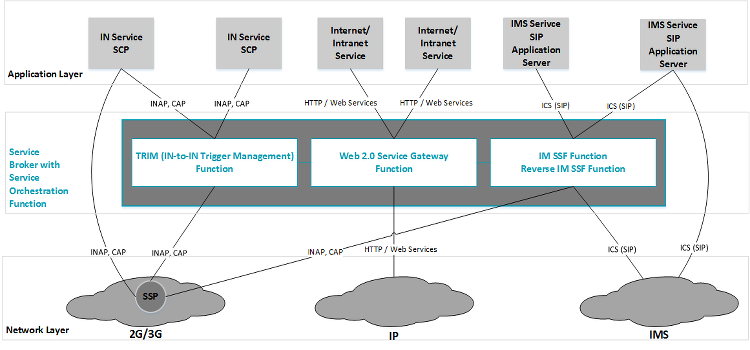JN Service Broker
Service orchestration and bundling in heterogeneous networks and/or protocols
Service Delivery Challenges
Facing a saturated and heavily regulated market and strong competition there, especially from over the top competitors, the telecommunications operator understand the vital importance of the agility in:
- offering new services quickly to a large swath of subscribers
- staying compatible with the existing services, provisioning and monetizing process
- orchestrating the existing services in service groups or bundles with additional value
In the same time, telecommunications operator do their business in an environment with different technologies in access and core networks, and with accumulated legacy services and equipment from different vendors. Each service is isolated in its own realm of technology, equipment and protocols. The services are typically available to a limited number of subscribers and are often bind to specific billing and management systems.
In result, the fluidity of service delivery process is severely limited.
Service Broker Technology
A technology for leveraging the existing subscriber base and the investments in legacy services and networks is crucially important.
Service Brokers bring this technology that helps to overcome the challenges faced by the telecommunications operators, to manage the service interaction and composition across different vendors and networks, and to deliver a broader range of competitive services quickly and efficiently. Service Brokers provide bridging between vendor specific equipment, different protocols, service domains, access and core networks. They radically increase the subscriber base for new and existing services, extend services to multiple domains, accelerate significantly time-to-market capabilities of the operators, simplify provisioning process, reduce OpEx costs through asset consolidation, shorten service monetizing time, and improve ARPU figures.

JN Service Broker Description
Applicata Service Broker is a modular solution that can be be configured with some or all of the following functions:
- Service Orchestration Function: provides open functionality to create and apply specific processing logic and orchestration rules that control the required interactions between the involved services and heterogeneous networks and protocols
- IN-to-IN Trigger Management (TRIM) Function: strings together multiple services in IN environment, originally designed and deployed to operate over different protocols and vendor-specific equipment
- IM-SSF Function:>enables IN-based applications to be applicable to IMS environments providing SIP – IN interworking to take advantage of legacy SCP assets.
- Reverse IM-SSF Function:extends 3GPP specifications enabling IMS-based services to be relevant to subscribers attached to IN-based infrastructures. New SIP based services can be provided to legacy subscribers on 2G/3G networks
- Web 2.0 Service Gateway Function: enables involvement of HTTP based services in service orchestration and bundling
IN Trigger Manager (TRIM) solution
Service Orchestration Function
Applicata Service Broker comes with a Service Orchestration Function for flexible orchestration and bundling the services. The Service Orchestration Function provides open functionality to create and apply specific processing logic and orchestration rules that control the required interactions between the involved services, heterogeneous service domains, networks and protocols. The orchestration rules are described using XML syntax.
The Service Orchestration Function provides an open functionality for:
- creating, deploying and applying specific processing logic for different service orchestration sessions
- analyzing the parameters of inbound protocol dialogues and/or messages and for routing these dialogues or messages to new or to existing service orchestration sessions
Features
- Open platform for integration of services from different vendors in different networks over different protocols
- Flexible service composition and orchestration logic defined in XML scripts
- Easy creation and modification of service orchestration logic
- Modular design
- High availability
- Performance scalability
- Rich protocol support: INAP, INAP CS1+, CAMEL 1,2,3 and 4, SIP, DIAMETER, HTTP
- Built on top of TeleStax / Mobicents Platform
Benefits
- Grant access for any service to any subscriber and core/access network domain
- Extend the subscriber base for new and existing services
- Easily orchestrate services from different vendors and networks based on different protocols to interact with each other without changing the service implementations
- Create bundles of services with added value
- Make legacy IN services available in NGN/IMS networks
- Interact with subscriber profile data and policy management procedures
- Break the dependencies of proprietary services on specific charging servers, offer any service to either post-paid or pre-paid subscribers
- Allow customers to mix or select between different charging options
- Protect current network assets and investments in services and applications
- Introduce new services over NGN
- Generate revenue and increase ARPU figures